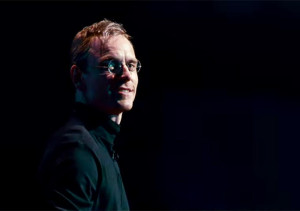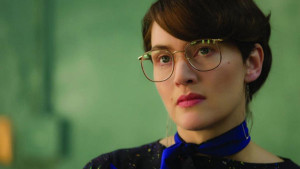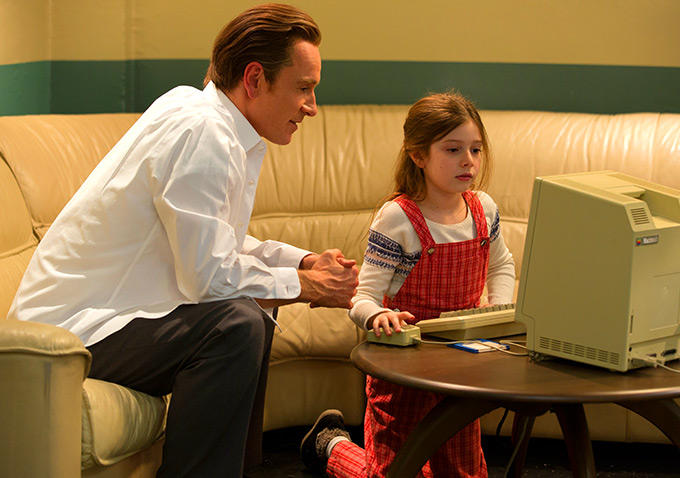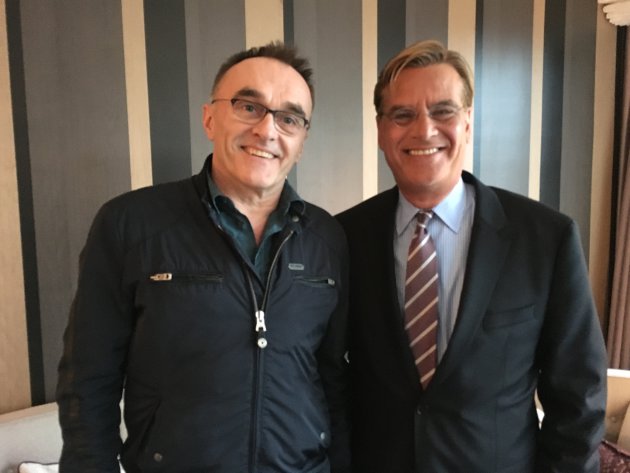Andrew Rostan was a film student before he realized that making comics was his horrible destiny, and he’s never shaken his love of cinema. Every week, he’ll opine on current pictures or important movies from the past.
During high school English, I learned the meaning of the term “well-made play:” an updating of Aristotle’s classical principles of drama that mostly came from the mind of French playwright Eugene Scribe. The well-made play is based around tight structure, plenty of off-screen action, a unity in time and place, key information that only certain characters know, and a fall-and-rise plot leading to a triumphant climax.
It may be about an innovator who helped build the world as we know it, but Steve Jobs is at its heart a filmed version of a well-made play, and this unusual choice makes it transcend the multitude of controversies concerning its journey to the screen, for the result is an unforgettable picture.
The Dramatist
Everyone now knows that Aaron Sorkin, working from the Walter Isaacson biography and his own interviews, wrote Steve Jobs according to the most formal and dense construction. The film consists of three long scenes, each containing a short flashback. Each scene sees Jobs have one-on-one interactions with the same set of characters, each conversation taking on a different tone and objective. This repetition and talkiness (the screenplay for the two-hour movie ran 182 pages) could have resulted in a very boring movie except for three fortunate occurrences.
First, Sorkin uses his formalism to explore as many aspects of Jobs’s complex character as possible. The structure allows him to avoid the “my life’s greatest hits” approach that plagued most of last year’s biopics and instead explore Jobs through how he interacts with people as his connections to and power balances with them change over time. These relationships would be treated with scant, simplified attention in a more conventional film of this sort, but in his careful detail Sorkin creates relationships that feel profoundly real.
Second, Sorkin’s gift for dialogue is at its height here. This is not surprising. However, one of the more striking attributes of his Oscar-winning The Social Network was its having comparatively less dialogue than some of his projects. Steve Jobs returns to the rapid-fire style of The West Wing with the high, never-boring quality of that show’s best episodes and The Social Network.
Third, Sorkin chooses one central theme and works very well with it through the picture: the relationship between parents and children. On a hubristic level of grandeur, Jobs, who compares himself to God in one of the film’s most brilliant moments (Chided for being a jerk, he responds “God sent his only son on a suicide mission, but we still love him because he made trees.”), envisions himself as a father figure for the world; a man who wants to give schools the best technology possible and put Apple in the home of every person. On a symbolic level, the person he clashes with the most is his own father figure, Apple CEO John Sculley, who by turns encourages and works against Jobs. And in terms of actual fatherhood, Jobs struggles with his feelings about being adopted and slowly builds a complicated relationship with his illegitimate daughter Lisa, who adores him even when she resents him. Jobs’s moments with Lisa are when the tempo slows and a man pokes out from the driven machine, building to the final ten minutes and a revelation that is comparatively small but works a thunderbolt of a tonal shift. The Social Network left Mark Zuckerberg in the mires of his loneliness, so the finale of Steve Jobs, who is built as an equal or greater figure to revile, almost feels like a cop-out due to how drastically sentimental it is compared to what went before, except that Sorkin has long tried to create happy or uplifting endings, and he has indeed laid the groundwork during the previous two hours.
The Staging
Danny Boyle has never made the same movie twice, but the common threads of his work serve to make him a perfect match for Sorkin, especially the Dickensian sense of plotting, character building, and satisfying conclusions best seen in Trainspotting and Slumdog Millionaire. Confronted with the three giant scenes, Boyle works in concert with Sorkin’s style. Steve Jobs is filled with perfectly composed backgrounds and foregrounds, ideal amounts of light and shade, and great character tableaux, but Boyle never lingers on any of these images so he can keep the pace with the rhythms of Sorkin’s dialogue. Boyle is not the same artist as David Fincher, and nothing in Steve Jobs matches the extraordinary opening of The Social Network, but his energetic touch is what the movie needs.
Boyle is ably supported by the top-notch editing of Elliot Graham, whose talents are particularly apparent in the cutting with the flashbacks, the cinematography of Alwin Kuchler, who shot the three acts in 16mm, 35mm, and digital to great effect, and composer Daniel Pemberton, whose score mixes grand opera and techno to good effect, as well as a stylish, scene-setting opening credit sequence.
The Cast
 Christian Bale, the original choice for the lead, has a history of playing warmer and more empathetic people. Michael Fassbender, who proves to be a perfect choice for Steve Jobs, is an actor who always brings out the most intense sides of his characters and, in the words of one of my best friends, “squicks people out.” Working with Sorkin’s dialogue, Fassbender quite often keeps himself still and relaxed while letting his twisting face and vocal dynamics express varying levels of annoyance, anger, and superiority. The three-part depiction of the arrogant wunderkind of 1984, the conspiratorial underdog of 1988, and the man searching for fulfillment in 1998 can make an audience turn from deserved hatred of Jobs at the beginning to a surprising, empathetic respect by the end.
Christian Bale, the original choice for the lead, has a history of playing warmer and more empathetic people. Michael Fassbender, who proves to be a perfect choice for Steve Jobs, is an actor who always brings out the most intense sides of his characters and, in the words of one of my best friends, “squicks people out.” Working with Sorkin’s dialogue, Fassbender quite often keeps himself still and relaxed while letting his twisting face and vocal dynamics express varying levels of annoyance, anger, and superiority. The three-part depiction of the arrogant wunderkind of 1984, the conspiratorial underdog of 1988, and the man searching for fulfillment in 1998 can make an audience turn from deserved hatred of Jobs at the beginning to a surprising, empathetic respect by the end.
Fassbender’s great gift in the film, however, is his ability to listen. Steve Jobs is never off the screen, but when other characters need to take the audience’s attention, Fassbender is the most active and generous of listeners, even when Jobs is only listening so he may rip them to shreds. This is best seen in a conversation that occurs in the orchestra pit of the San Francisco Opera House between Jobs and Seth Rogen’s Steve Wozniak that travels from funny to philosophical to full of deeply-rooted pain, love, and rage rising up from Wozniak. It is a stirring moment for Rogen that reveals the gifted comic and writer has a knack for more serious parts.
 The actresses deserve the most praise. Katherine Waterston gives a terrific, troubling turn as Jobs’s ex-lover Chrisanne, and Kate Winslet is spectacular as Joanna Hoffman, Jobs’s marketing director and unofficial conscience. Winslet is as commanding as Fassbender and also utilizes the three-act structure to physically change her performance as no one else does, for as Hoffman grows in stature and confidence, Winslet makes her Polish accent more pronounced and ditches the owl glasses, business suit, and tightly bunned hair, revealing a person comfortable in her skin. Finally, very special mention must be made for Makenzie Moss, Ripley Sobo, and Perla Haney-Jardine, who play Lisa at the various ages of her life and look, move, and sound enough alike that the film feels like it followed the same girl for fifteen years, and who allow the audience to build an emotional connection for Jobs and the story as no one else in the film does.
The actresses deserve the most praise. Katherine Waterston gives a terrific, troubling turn as Jobs’s ex-lover Chrisanne, and Kate Winslet is spectacular as Joanna Hoffman, Jobs’s marketing director and unofficial conscience. Winslet is as commanding as Fassbender and also utilizes the three-act structure to physically change her performance as no one else does, for as Hoffman grows in stature and confidence, Winslet makes her Polish accent more pronounced and ditches the owl glasses, business suit, and tightly bunned hair, revealing a person comfortable in her skin. Finally, very special mention must be made for Makenzie Moss, Ripley Sobo, and Perla Haney-Jardine, who play Lisa at the various ages of her life and look, move, and sound enough alike that the film feels like it followed the same girl for fifteen years, and who allow the audience to build an emotional connection for Jobs and the story as no one else in the film does.
Steve Jobs is, again, an unusual, swirling almost-mess of a film in those three giant scenes, but it is an excellent film that subverts the biopic conventions, displays the talents of so many at their best, and boasts a rare depth of character and theme. Well-made indeed.
Steve Jobs is currently in cinemas. Photos from Endgadget, Gold Derby, and Indiewire.






